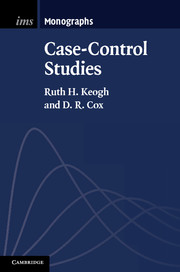Refine search
Actions for selected content:
2703 results in General statistics and probability
PART II - GENERAL INSURANCE
-
- Book:
- Computation and Modelling in Insurance and Finance
- Published online:
- 05 May 2014
- Print publication:
- 10 April 2014, pp 277-278
-
- Chapter
- Export citation
4 - Monte Carlo II: Improving technique
- from PART I - TOOLS FOR RISK ANALYSIS
-
- Book:
- Computation and Modelling in Insurance and Finance
- Published online:
- 05 May 2014
- Print publication:
- 10 April 2014, pp 97-137
-
- Chapter
- Export citation

Case-Control Studies
-
- Published online:
- 05 April 2014
- Print publication:
- 06 March 2014
Preamble
-
- Book:
- Case-Control Studies
- Published online:
- 05 April 2014
- Print publication:
- 06 March 2014, pp 1-7
-
- Chapter
- Export citation
Notes
-
- Book:
- Case-Control Studies
- Published online:
- 05 April 2014
- Print publication:
- 06 March 2014, pp 7-7
-
- Chapter
- Export citation
Appendix: A theoretical diversion
-
- Book:
- Case-Control Studies
- Published online:
- 05 April 2014
- Print publication:
- 06 March 2014, pp 252-261
-
- Chapter
- Export citation
Contents
-
- Book:
- Case-Control Studies
- Published online:
- 05 April 2014
- Print publication:
- 06 March 2014, pp v-viii
-
- Chapter
- Export citation
1 - Introduction to case-control studies
-
- Book:
- Case-Control Studies
- Published online:
- 05 April 2014
- Print publication:
- 06 March 2014, pp 8-30
-
- Chapter
- Export citation
Preface
-
- Book:
- Case-Control Studies
- Published online:
- 05 April 2014
- Print publication:
- 06 March 2014, pp ix-x
-
- Chapter
- Export citation
References
-
- Book:
- Case-Control Studies
- Published online:
- 05 April 2014
- Print publication:
- 06 March 2014, pp 262-280
-
- Chapter
- Export citation
9 - Misclassification and measurement error
-
- Book:
- Case-Control Studies
- Published online:
- 05 April 2014
- Print publication:
- 06 March 2014, pp 212-239
-
- Chapter
- Export citation
4 - A general formulation
-
- Book:
- Case-Control Studies
- Published online:
- 05 April 2014
- Print publication:
- 06 March 2014, pp 83-110
-
- Chapter
- Export citation
Index
-
- Book:
- Case-Control Studies
- Published online:
- 05 April 2014
- Print publication:
- 06 March 2014, pp 281-285
-
- Chapter
- Export citation
8 - Case-subcohort studies
-
- Book:
- Case-Control Studies
- Published online:
- 05 April 2014
- Print publication:
- 06 March 2014, pp 191-211
-
- Chapter
- Export citation
7 - Nested case-control studies
-
- Book:
- Case-Control Studies
- Published online:
- 05 April 2014
- Print publication:
- 06 March 2014, pp 160-190
-
- Chapter
- Export citation
Frontmatter
-
- Book:
- Case-Control Studies
- Published online:
- 05 April 2014
- Print publication:
- 06 March 2014, pp i-iv
-
- Chapter
- Export citation
6 - Special sampling designs
-
- Book:
- Case-Control Studies
- Published online:
- 05 April 2014
- Print publication:
- 06 March 2014, pp 132-159
-
- Chapter
- Export citation
2 - The simplest situation
-
- Book:
- Case-Control Studies
- Published online:
- 05 April 2014
- Print publication:
- 06 March 2014, pp 31-61
-
- Chapter
- Export citation
5 - Case-control studies with more than two outcomes
-
- Book:
- Case-Control Studies
- Published online:
- 05 April 2014
- Print publication:
- 06 March 2014, pp 111-131
-
- Chapter
- Export citation
3 - Matched case-control studies
-
- Book:
- Case-Control Studies
- Published online:
- 05 April 2014
- Print publication:
- 06 March 2014, pp 62-82
-
- Chapter
- Export citation
